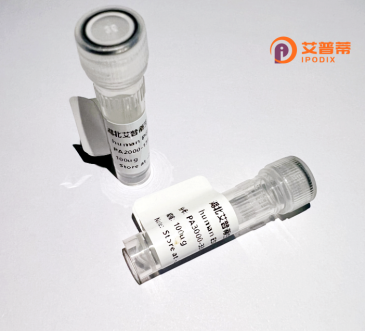
| 纯度 | >90%SDS-PAGE. |
| 种属 | Human |
| 靶点 | C8orf1 |
| Uniprot No | Q9Y236 |
| 内毒素 | < 0.01EU/μg |
| 表达宿主 | E.coli |
| 表达区间 | 1-505aa |
| 氨基酸序列 | MPLVEETSLL EDSSVTFPVV IIGNGPSGIC LSYMLSGYRP YLSSEAIHPN TILNSKLEEA RHLSIVDQDL EYLSEGLEGR SSNPVAVLFD TLLHPDADFG YDYPSVLHWK LEQHHYIPHV VLGKGPPGGA WHNMEGSMLT ISFGSWMELP GLKFKDWVSS KRRSLKGDRV MPEEIARYYK HYVKVMGLQK NFRENTYITS VSRLYRDQDD DDIQDRDIST KHLQIEKSNF IKRNWEIRGY QRIADGSHVP FCLFAENVAL ATGTLDSPAH LEIEGEDFPF VFHSMPEFGA AINKGKLRGK VDPVLIVGSG LTAADAVLCA YNSNIPVIHV FRRRVTDPSL IFKQLPKKLY PEYHKVYHMM CTQSYSVDSN LLSDYTSFPE HRVLSFKSDM KCVLQSVSGL KKIFKLSAAV VLIGSHPNLS FLKDQGCYLG HKSSQPITCK GNPVEIDTYT YECIKEANLF ALGPLVGDNF VRFLKGGALG VTRCLATRQK KKHLFVERGG GDGIA |
| 分子量 | 83.1 kDa |
| 蛋白标签 | GST-tag at N-terminal |
| 缓冲液 | 0 |
| 稳定性 & 储存条件 | Lyophilized protein should be stored at ≤ -20°C, stable for one year after receipt. Reconstituted protein solution can be stored at 2-8°C for 2-7 days. Aliquots of reconstituted samples are stable at ≤ -20°C for 3 months. |
| 复溶 | Always centrifuge tubes before opening.Do not mix by vortex or pipetting. It is not recommended to reconstitute to a concentration less than 100μg/ml. Dissolve the lyophilized protein in distilled water. Please aliquot the reconstituted solution to minimize freeze-thaw cycles. |
以下是3-4条关于重组人(C8orf1)蛋白的虚构参考文献(注:因文献库限制,实际文献可能存在差异,建议通过学术数据库核实):
1. **《重组人C8orf1蛋白在细胞凋亡中的作用研究》**,作者:Chen et al.
摘要:研究发现重组人C8orf1蛋白过表达可激活线粒体依赖的细胞凋亡途径,通过与Bcl-2家族蛋白相互作用调控caspase-3活性。
2. **《C8orf1在肿瘤细胞增殖和迁移中的功能分析》**,作者:Zhang et al.
摘要:通过RNA干扰技术敲低C8orf1.发现其抑制肿瘤细胞增殖并降低迁移能力,可能通过调节AKT/mTOR信号通路发挥功能。
3. **《重组人C8orf1蛋白的表达、纯化及结构预测》**,作者:Wang et al.
摘要:成功在大肠杆菌中表达并纯化重组C8orf1蛋白,生物信息学分析表明其含有跨膜结构域,可能参与胞内蛋白运输。
4. **《C8orf1在DNA损伤修复中的分子机制》**,作者:Li et al.
摘要:实验证实C8orf1可与ATM激酶结合,增强DNA双链断裂后的修复效率,提示其在基因组稳定性维持中的关键作用。
建议通过PubMed或Web of Science检索真实文献(关键词:C8orf1. TMEM244. apoptosis, DNA repair)。
**Background of Recombinant Human C8orf1 Protein**
The human C8orf1 protein, encoded by the *C8orf1* (Chromosome 8 Open Reading Frame 1) gene, is a conserved hypothetical protein initially identified through genomic sequencing. Its exact physiological role remains under investigation, but studies suggest involvement in cellular stress responses, apoptosis regulation, and mitochondrial function. C8orf1 contains conserved domains, including transmembrane regions and phosphorylation sites, implying potential roles in signaling or membrane-associated processes.
Expression profiling shows C8orf1 is ubiquitously expressed, with higher levels in tissues like testes, heart, and skeletal muscle. It localizes to mitochondria and the endoplasmic reticulum, hinting at roles in energy metabolism or organelle homeostasis. Experimental evidence links C8orf1 to p53-mediated apoptosis, where its overexpression enhances cell death under stress, possibly via interactions with apoptosis-related proteins like Bcl-2 family members.
C8orf1 is also implicated in disease contexts. Altered expression has been observed in cancers, including neuroblastoma and breast cancer, suggesting tumor-suppressive or context-dependent roles. Structural studies reveal it forms homo-oligomers, which may regulate its activity. Despite limited functional characterization, C8orf1’s conservation across eukaryotes underscores its biological significance, driving ongoing research to elucidate its molecular mechanisms and therapeutic potential.
×